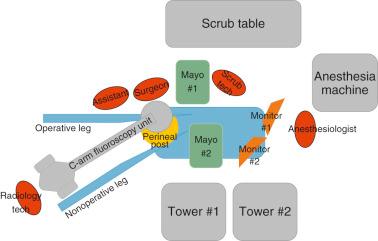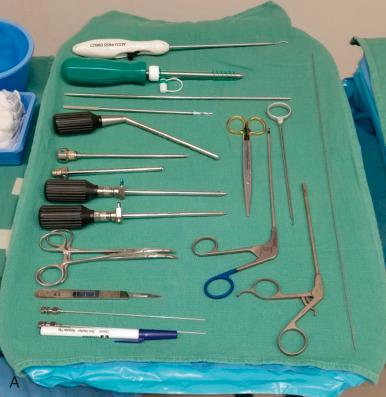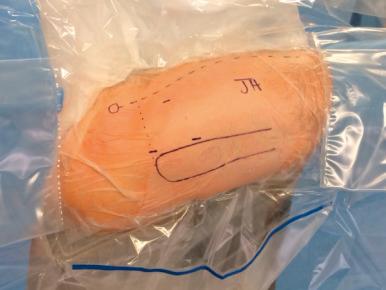Physical Address
304 North Cardinal St.
Dorchester Center, MA 02124
The technique of hip arthroscopy has undergone a period of rapid evolution and growth. In its infancy, hip arthroscopy was mostly for diagnostic and limited therapeutic utility. It was “a technique looking for indications.” Now, improved understanding of intra- and extra-articular hip disease has led to increased investigation of both non- and prearthritic hip disorders. The unique technical challenges to arthroscopic access imposed by the hip joint, different from that of the knee and shoulder, include its deep location surrounded by multiple musculotendinous and neurovascular structures, “ball and socket” type joint congruity requiring traction, and necessity of variable degrees of capsular incision for visualization and instrumentation. Improved equipment and technique has now permitted safer and easier arthroscopic and endoscopic access to virtually any musculoskeletal structure around the hip. Thus hip arthroscopy is now able to effectively diagnose and treat most hip pathology. This largely accounts for the proliferation in performance of hip arthroscopy in the United States and across the world.
Indications for hip arthroscopy are based on a thorough history, physical examination, and imaging analysis. The Warwick Agreement defined femoroacetabular impingement (FAI) syndrome as a motion-related clinical disorder based on the triad of symptoms (history), clinical signs (physical examination), and imaging findings (plain radiographs and advanced imaging). Symptoms typically are motion- or position-related hip and/or groin pain. Pain may also be experienced in the back, buttock, or thigh. Mechanical symptoms such as catching, clicking, locking, stiffness, loss of motion, or giving way may also be perceived. A variety of hip impingement tests may be used to elicit the patient's typical “chief complaint” pain. The flexion-adduction-internal rotation (FADIR) is the most common test for impingement. Restricted hip flexion and internal and/or external rotation are frequently observed. Orthogonal views of the pelvis, including an anteroposterior (AP) and one of many lateral views (e.g., Dunn, frog-leg, cross-table, false profile), are used to identify cam and/or pincer morphology. Confirmation of all three components of the triad during the medical decision-making component of the treatment algorithm for patients with hip pain, in most cases, warrants a trial of nonsurgical measures (rest, activity modification, education, oral nonnarcotic medications, physical therapy, selective intra-articular injections). In the event of failure of nonsurgical treatment, patient dissatisfaction with their current hip condition may indicate hip arthroscopy.
The primary indications for hip arthroscopy include FAI syndrome due to either cam and/or pincer morphology, labral injury, femoral head and/or acetabular articular cartilage injury, intra-articular loose bodies (e.g., synovial chondromatosis, localized focal pigmented villonodular synovitis), septic arthritis, and certain types of “extra-articular” impingement (e.g., anterior inferior iliac spine [AIIS] subspine impingement, iliopsoas impingement). Patient selection is critical in recognition of one or more of these indications that frequently coexist. Patient selection is even more critical in recognition of any contraindications that could portend an increased risk of failure, complications, reoperations, or conversion to total hip arthroscopy.
Contraindications to hip arthroscopy include advanced hip osteoarthritis, more than mild or borderline dysplasia (without concomitant simultaneous or staged periacetabular osteotomy), and patients with asymptomatic cam or pincer morphology. Patients with advanced joint space narrowing along the weight bearing sourcil (<2 mm) are at a significantly higher risk of failure of arthroscopy. Other radiographic signs of advanced arthrosis include subchondral acetabular cyst formation, osteophytes, subchondral sclerosis, and Tönnis 2 or 3 classification. These patients are better treated with either continued nonsurgical measures or arthroplasty. Patients with clinical and radiographic features of significant acetabular dysplasia include those with a lateral center edge angle (and anterior center edge angle) of less than 18 to 20 degrees, a Tönnis angle of greater than 15 degrees (acetabular index), a femoral head extrusion index greater than 25%, a broken Shenton's line, femoral head migration, percent medialization of the iliofemoral line, and an elevated FEAR (Femoro-Epiphyseal Acetabular Roof) Index. Although technically more challenging, patients with protrusio acetabuli (femoral head medial border is medial to the ilioischial line) pincer morphology are not contraindicated and may be successfully managed arthroscopically. Given the high prevalence of cam (37%; 55% in athletes and 23% in nonathletes) and pincer (67%) morphology in asymptomatic individuals, surgeons must always remember to “treat the patient, not the x-ray.” There is no role for prophylactic arthroscopic hip preservation surgery in asymptomatic individuals.
A steep learning curve is associated with performance of hip arthroscopy. Surgeons must be aware of this learning curve and do as much as possible to reduce the risk of adverse events during the curve. This includes both observation and hands-on training with an experienced hip arthroscopist(s). Attendance at society, institutional, and/or industry cadaveric laboratory workshops are highly valuable in learning the techniques, equipment, and instrumentation. Patient-reported outcome scores, reoperation rate, arthroplasty conversion rate, operative time, complication rates, failure rates, and patient satisfaction have all been shown to significantly improve with greater surgeon experience. Additionally, the rate of iatrogenic articular cartilage and labral injury during portal placement (the most common hip arthroscopy complication at the most likely time) has been shown to be reduced with greater surgeon experience.
Prior to entering the operating room theatre, the patient's correct site (hip) and side (right vs. left) are marked by the surgeon, and confirmed with the preoperative medical records and written informed consent form. A multimodal pain management protocol is begun in the preoperative holding area in order to reduce the need for postoperative narcotic use. The author's preferred “cocktail” includes oral acetaminophen 500 mg, celecoxib 400 mg, pregabalin 75 mg, famotidine 20 mg, and promethazine 12.5 mg; and transdermal postauricular scopolamine 1 mg patch. Upon entry into the operating room, intravenous antibiotic (cefazolin—first generation cephalosporin [1 g if <75 kg body weight; 2 g if 75 kg or greater] or clindamycin [600 mg] if allergic to penicillin or cephalosporin) is commenced within 30 minutes of anticipated skin incision.
Dedicated hip arthroscopy instrument sets are necessary to effectively perform hip arthroscopy. A variety of different arthroscopy towers exist to hold the camera system, camera light source, arthroscopy image/video data source and printer, arthroscopy fluid pump, arthroscopy suction canister and storage source, radiofrequency system, and shaver/burr power system ( Fig. 79.1 ). The video monitor may be on the tower or on a separate ceiling or wall fixture, to visualize the arthroscopy video on one screen and fluoroscopy images on a separate screen. The arthroscopic fluid pump should be at a low pressure (40 to 50 mm Hg) with high flow in order to reduce the risk of fluid extravasation outside the hip joint, potentially into the pelvis, abdomen, retroperitoneum, or chest. The instruments necessary to perform hip arthroscopy may be placed on the scrub technician's back table and at least one Mayo stand ( Figs. 79.1 and 79.2A to C ). The instruments used for hip arthroscopy, as opposed to knee or shoulder arthroscopy, must be longer in some circumstances. The deep location, thick muscular envelope, and sometimes adipose layer may make standard joint arthroscopy instruments too short to successfully reach the joint. Additionally, the congruent spherical nature of the joint makes curved and flexible instrumentation necessary.


A variety of operating room tables may be used to successfully perform hip arthroscopy. These include fracture tables, joint replacement tables, and hip arthroscopy-specific traction tables. Although the author prefers the supine position, lateral decubitus is also a viable option. The author prefers the Advanced Supine Hip Positioning System with two Universal Hip Distractors and two Active Heel Traction Boots (Smith & Nephew, Andover, MA) and a well-padded perineal post (~25 cm diameter) between the legs. The table has a perineal post holder that is eccentrically located toward the operative side to increase the lateral vector during distraction and reduce pressure on the perineum. Each soft boot is securely placed and Velcro strapped in the Active Heel Traction Boot so that no creases, rivets, grooves, or bulges would cause excessive pressure on each foot or ankle. A self-adherent elastic bandage is placed over the soft boot to increase the surface friction once placed in the Active Heel Traction Boot to reduce the risk of the foot pulling out of the Active Heel Traction Boot.
Examination under anesthesia is performed. This includes measurement of bilateral hip flexion, abduction, and internal and external rotation at 90 degrees hip flexion. Assessment of external rotation recoil, dial testing (maximal limb internal rotation and permissive passive external rotation assessment for endpoint and greater than 45 degrees of external rotation), and traction testing (with or without fluoroscopic assistance) all evaluate capsular (especially the iliofemoral ligament) integrity. Fluoroscopic examination under anesthesia can be helpful to accurately identify trochanteric-pelvic and ischiofemoral impingement. Femoral head translation, in addition to rotation, may also be fluoroscopically observed if the head-neck junction levers on the acetabular fulcrum (microinstability) with or without the presence of a vacuum sign.
General anesthesia with complete muscle relaxation paralysis reduces the force necessary to obtain sufficient distraction (<50 to 75 pounds) for atraumatic entry into the hip joint. In the lateral position, for every pound increase in distraction force applied, there is a 4% increase in odds of an adverse nerve event. While traction time has not been shown to influence the risk of a postoperative nerve palsy, the duration should be under 2 hours to reduce the risk of a compressive, ischemic “tourniquet-like” effect on the nerves in the perineum. In order to reduce the risk of perineal injury secondary to traction, some authors have performed successful “postless” hip arthroscopy without a perineum or groin complication. The most common complication of hip arthroscopy is iatrogenic articular cartilage and/or labral injury (0.4% to 3.8% and 0.7% to 18%, respectively), occurring primarily during portal placement. Thus patient positioning and traction must optimize the ability to successfully place portals with a reduced, and potentially eliminated, risk of iatrogenic chondrolabral injury.
Once the patient's feet are securely placed in the traction boots and all bony and soft tissue prominences padded (especially the perineum), distraction commences. A surgical pause “time-out” is performed prior to the initiation of distraction. The nonoperative limb is first placed in approximately 5 degrees of flexion, 45 to 60 degrees of abduction, and neutral rotation. A gentle axial longitudinal distractive pull is applied to provide a counter-traction lateral force to the operative side. The operative limb is placed in approximately 30 degrees abduction and 30 degrees of flexion in neutral rotation and a gentle axial longitudinal distractive pull applied. Next, in a slow, gentle application of zig-zagging hip extension-adduction, extension-adduction, extension-adduction moments, the operative limb is positioned in approximately 5 degrees flexion, 5 degrees adduction, and neutral rotation. The limb is then internally rotated to the degree of femoral anteversion (measured from preoperative imaging, either computed tomography [CT] scan or 3D biplanar fluoroscopy EOS) (if 20 degrees anteversion, then 20 degrees internal rotation). A minimum of 10 mm of distraction is necessary to safely proceed. The C-arm fluoroscopic unit is placed between the legs, roughly parallel with the nonoperative limb, and does not interfere with the surgeon or limb manipulation before or after traction application.
Sterile preparation and draping of the limb with an Isolation Drape with Incise Film and Pouch (3M Health Care, St. Paul, MA) allows for quick and easy application of a surgical drape that protects the sterile field and covers the patient's body ( Fig. 79.3 ). Using a sterile marker, a straight line is drawn connecting the anterior superior iliac spine and the patella. No portal should be established at or medial to this line. If posterior portals (posterolateral [PL] or accessory/modified PL) are to be established, the draping must ensure to not block out portal placement posteriorly.

Tactile sensation of surface landmarks is used to assist in portal placement during hip arthroscopy. Given the deep constrained nature of the joint, even small errors in portal location can significantly limit access to intra- and extra-articular structures. The anterior superior iliac spine, greater trochanter (tip, anterior and posterior margins), and patella are the primary landmarks used. These are reliably and accurately located in most patients’ body habiti. Traction and adduction may assist in further defining the anterior abductor margin. A 17-gauge spinal needle may be used to estimate the approximate starting point and trajectory of the initial portal placed, the anterolateral (AL) portal. Fluoroscopy is used to ensure correct placement. Over time, both fluoroscopy time and absorbed radiation dose significantly decrease over the first 100 cases of a surgeon's learning curve.
Become a Clinical Tree membership for Full access and enjoy Unlimited articles
If you are a member. Log in here